| Arhopala | |
|---|---|
 | |
| Arhopala japonica is of unclear affiliations. When Narathura was considered distinct, it was placed there. | |
| Scientific classification | |
| Domain: | Eukaryota |
| Kingdom: | Animalia |
| Phylum: | Arthropoda |
| Class: | Insecta |
| Order: | Lepidoptera |
| Family: | Lycaenidae |
| Tribe: | Arhopalini |
| Genus: | Arhopala Boisduval, 1832 |
| Type species | |
| Arhopala phryxus Boisduval, 1832 | |
| Diversity | |
| About 220 species | |
| Synonyms | |
|
Several, see text | |

Arhopala is a very large genus of gossamer-winged butterflies (Lycaenidae). They are the type genus of the tribe Arhopalini. In the relatively wide circumscription used here, it contains over 200 species collectively known as oakblues. They occur from Japan throughout temperate to tropical Asia south and east of the Himalayas to Australia and the Solomon Islands of Melanesia. Like many of their relatives, their caterpillars are attended and protected by ants (myrmecophily). Sexual dichromatism is often prominent in adult oakblues.[1]
The genus' delimitation versus Amblypodia and Flos has proven to be problematic; not all issues are resolved and the assignment of species to these genera must be considered somewhat provisional.
Systematics
As circumscribed here, this genus includes many formerly independent genera. Junior synonyms of Arhopala are:[1]
- Acesina Moore, 1884
- Aurea Evans, 1957
- Daranasa Moore, 1884 (lapsus)
- Darasana Moore, 1884
- "Iois" Doherty, 1899 (nomen nudum)
- Narathura Moore, 1879
- Nilasera Moore, 1881
- Panchala Moore, 1882
- Satadra Moore, 1884
The species have been provisionally sorted into groups of presumed closest relatives, but many species remain insufficiently studied even for such a preliminary assessment at present. For example, A. phryxus – the type species used by Jean Baptiste Boisduval when he described Arhopala in 1832 – was established at the same time as and specifically for this genus. It is considered to be a valid species of unclear affiliations, but it is suspected that Boisduval's taxon is a junior synonym of A. thamyras – the namesake of its species group – which had been described as Papilio thamyras by Carl Linnaeus already in 1764.[2]
Molecular phylogenetic studies have only sampled a fraction of the known diversity of oakblues, but as it seems at least some of the groups represent clades that could justifiably be treated as subgenera. It is also to be seen, however, if the genus is monophyletic in the loose sense as used here, or would need to be split up again.[1]
Species
Species are listed alphabetically, while the groups are listed in the presumed phylogenetic sequence:[2]
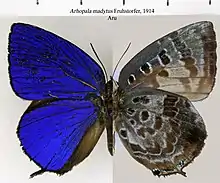
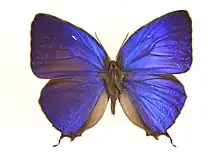
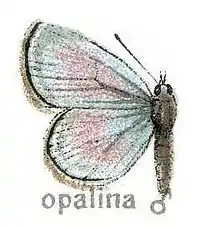
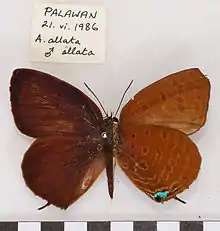
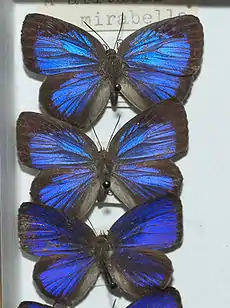
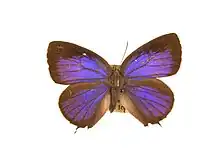

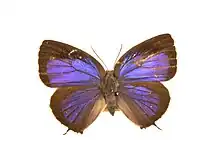

|
centaurus group (subgenus Nilasera if valid)
agesias group
anthelus group (subgenus Narathura if valid)
camdeo group
oenea group
epimuta group
amphimuta group
agesilaus group
alitaeus group
|
agrata group
cleander group
eumolphus group
rama group
agelastus group
fulla group
aurea group (subgenus Aurea if valid)
ganesa group (subgenus Panchala if valid)
abseus group
thamyras group
hercules group
|


|
|
Footnotes
References
- Brower, Andrew V. Z. (2008): Tree of Life Web Project – Arhopala. Version of 2008-APR-09. Retrieved 2009-MAR-21.
- Savela, Markku (2008): Markku Savela's Lepidoptera and Some Other Life Forms – Arhopala. Version of 2008-AUG-06. Retrieved 2009-MAR-21.
- Evans, W H, 1957 A revision of the Arhopala group of Oriental Lycaenidae (Lepidoptera: Rhopalocera) Bulletin of the British Museum (Natural History), London, Entomology Volume 5 : 85- 141 online